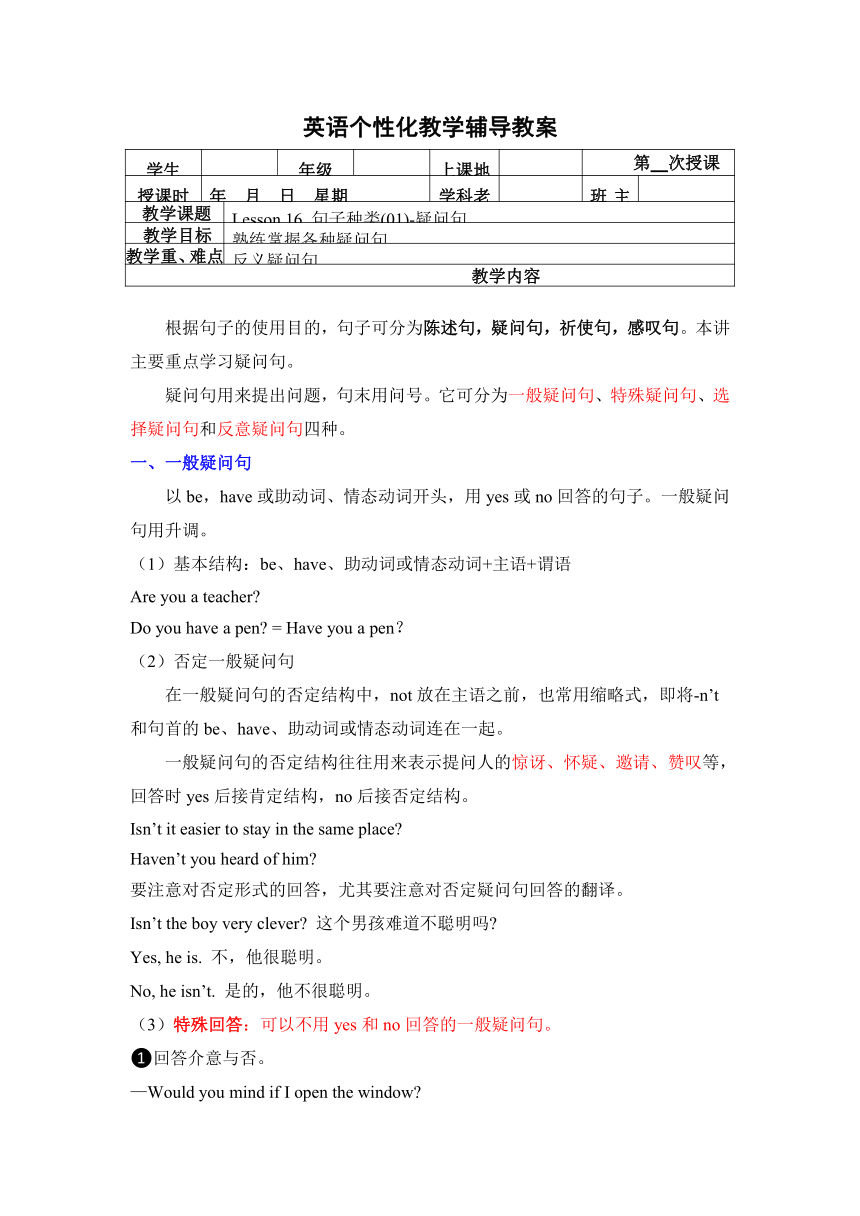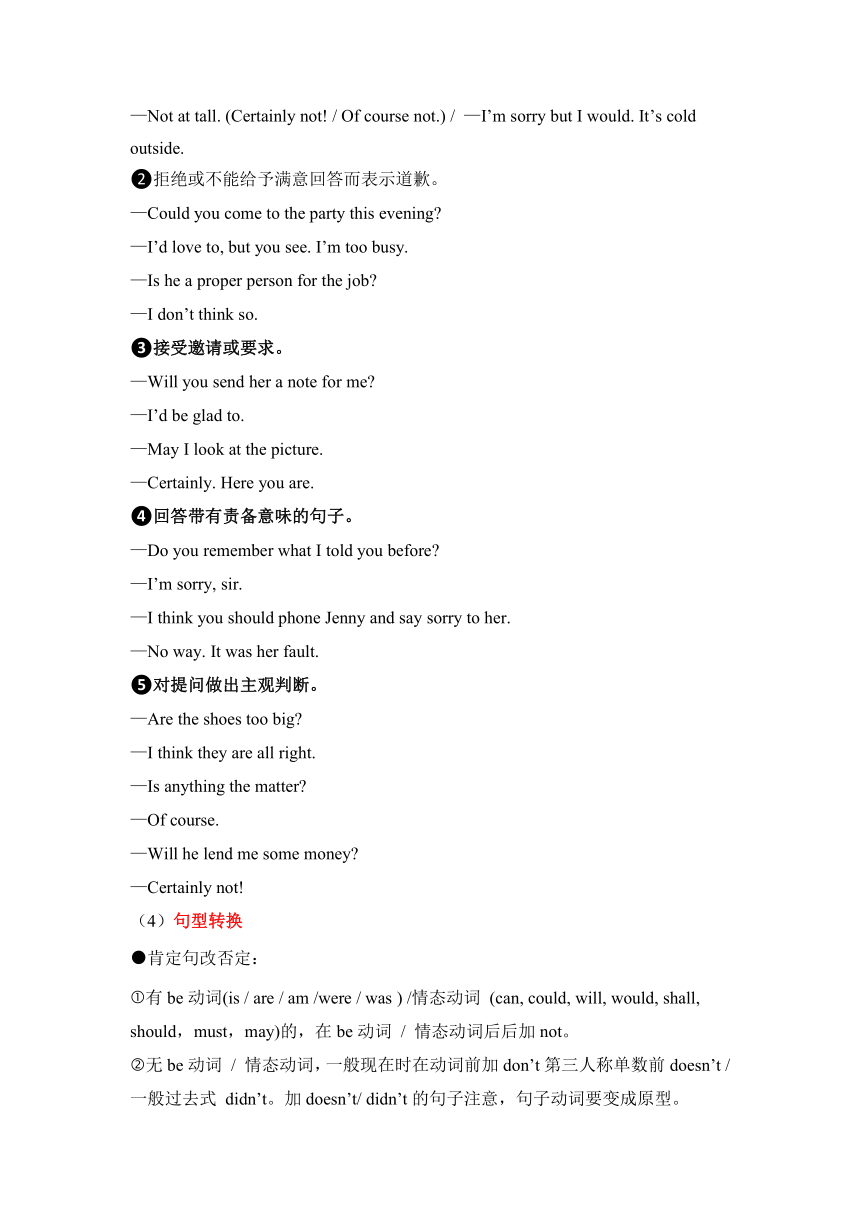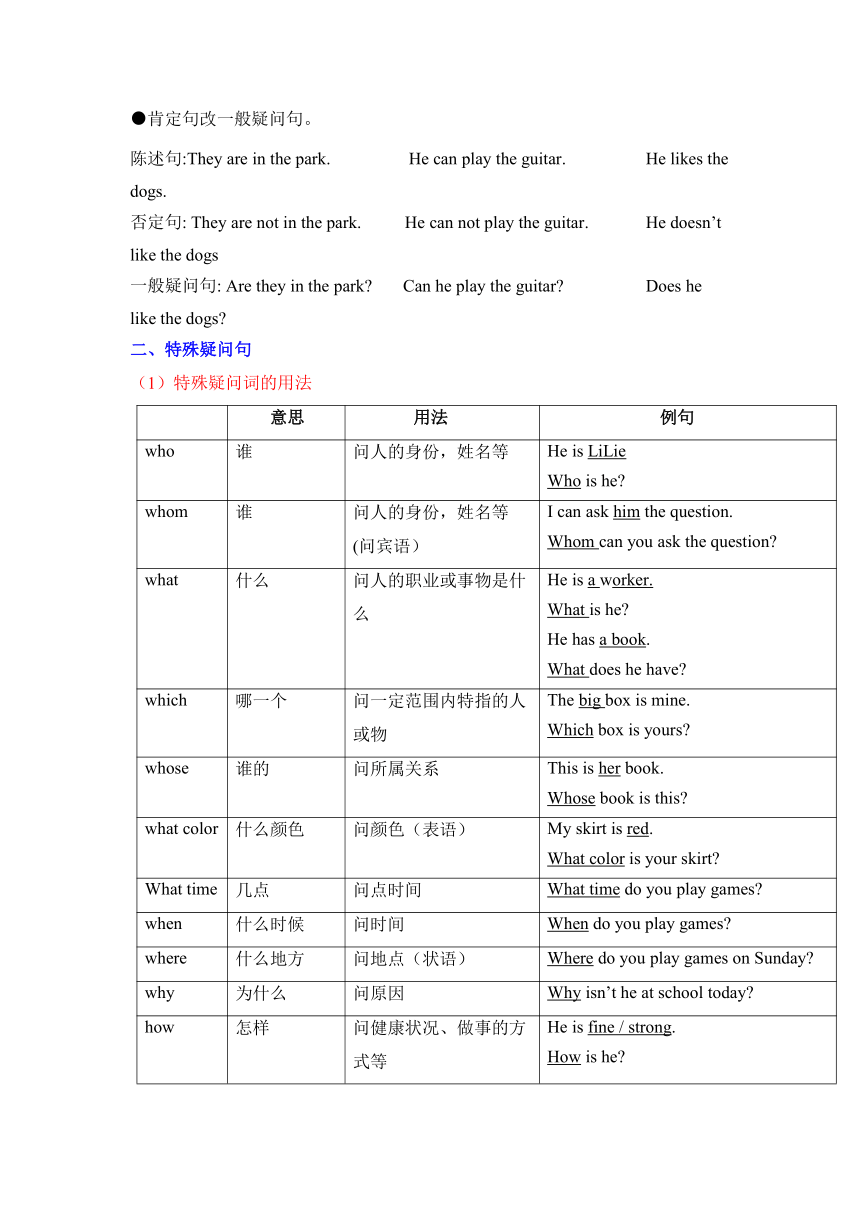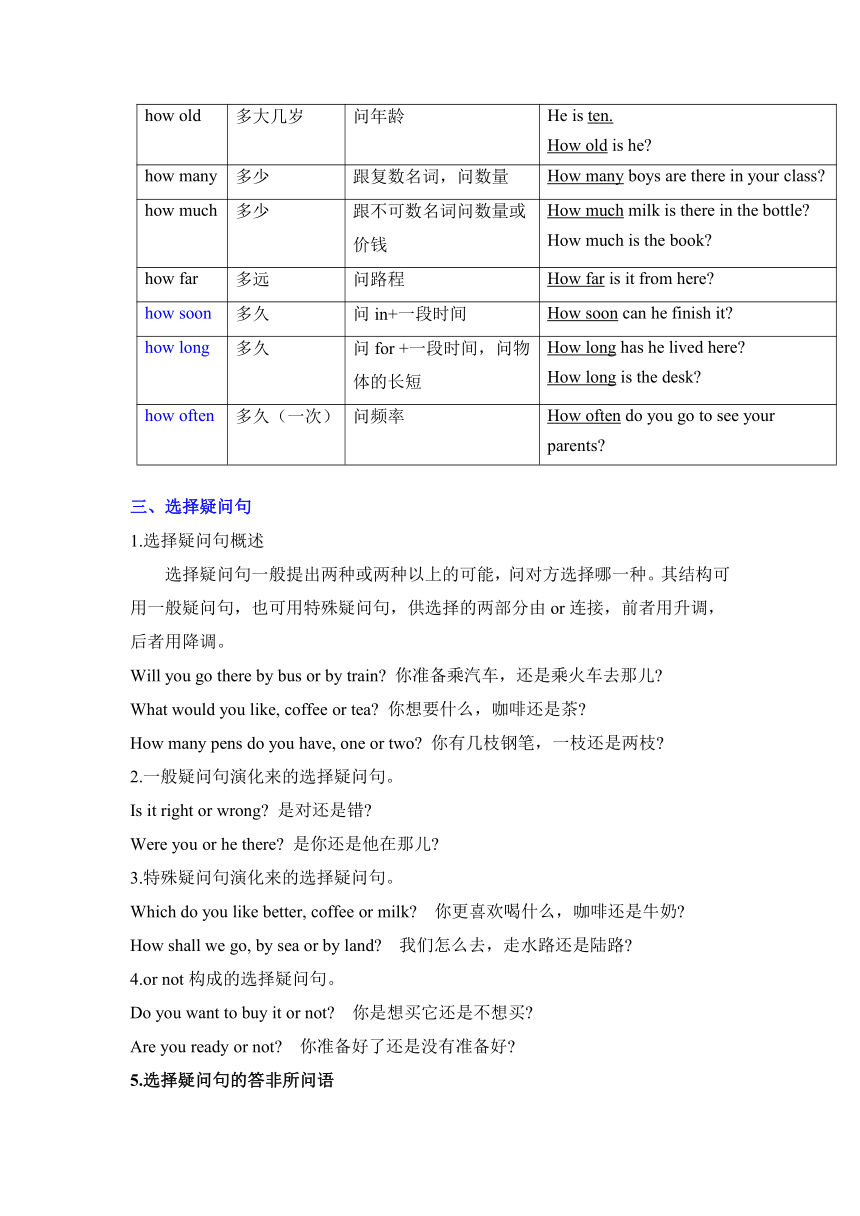2021年中考英语语法专题-第16讲句子种类(1)反意疑问句、疑问句教案
文档属性
| 名称 | 2021年中考英语语法专题-第16讲句子种类(1)反意疑问句、疑问句教案 |

|
|
| 格式 | zip | ||
| 文件大小 | 26.9KB | ||
| 资源类型 | 教案 | ||
| 版本资源 | 人教新目标(Go for it)版 | ||
| 科目 | 英语 | ||
| 更新时间 | 2022-01-03 22:26:15 | ||
图片预览




文档简介
英语个性化教学辅导教案
学生 年级 上课地点 第 次授课
授课时间 年 月 日 星期 学科老师 班主任
教学课题 Lesson 16 句子种类(01)-疑问句
教学目标 熟练掌握各种疑问句
教学重、难点 反义疑问句
教学内容
根据句子的使用目的,句子可分为陈述句,疑问句,祈使句,感叹句。本讲主要重点学习疑问句。
疑问句用来提出问题,句末用问号。它可分为一般疑问句、特殊疑问句、选择疑问句和反意疑问句四种。
一、一般疑问句
以be,have或助动词、情态动词开头,用yes或no回答的句子。一般疑问句用升调。
(1)基本结构:be、have、助动词或情态动词+主语+谓语
Are you a teacher
Do you have a pen = Have you a pen?
(2)否定一般疑问句
在一般疑问句的否定结构中,not放在主语之前,也常用缩略式,即将-n’t和句首的be、have、助动词或情态动词连在一起。
一般疑问句的否定结构往往用来表示提问人的惊讶、怀疑、邀请、赞叹等,回答时yes后接肯定结构,no后接否定结构。
Isn’t it easier to stay in the same place
Haven’t you heard of him
要注意对否定形式的回答,尤其要注意对否定疑问句回答的翻译。
Isn’t the boy very clever 这个男孩难道不聪明吗
Yes, he is. 不,他很聪明。
No, he isn’t. 是的,他不很聪明。
(3)特殊回答:可以不用yes和no回答的一般疑问句。
回答介意与否。
—Would you mind if I open the window
—Not at tall. (Certainly not! / Of course not.) / —I’m sorry but I would. It’s cold outside.
拒绝或不能给予满意回答而表示道歉。
—Could you come to the party this evening
—I’d love to, but you see. I’m too busy.
—Is he a proper person for the job
—I don’t think so.
接受邀请或要求。
—Will you send her a note for me
—I’d be glad to.
—May I look at the picture.
—Certainly. Here you are.
回答带有责备意味的句子。
—Do you remember what I told you before
—I’m sorry, sir.
—I think you should phone Jenny and say sorry to her.
—No way. It was her fault.
对提问做出主观判断。
—Are the shoes too big
—I think they are all right.
—Is anything the matter
—Of course.
—Will he lend me some money
—Certainly not!
(4)句型转换
●肯定句改否定:
有be动词(is / are / am /were / was ) /情态动词 (can, could, will, would, shall, should,must,may)的,在be动词 / 情态动词后后加not。
无be动词 / 情态动词,一般现在时在动词前加don’t第三人称单数前doesn’t / 一般过去式 didn’t。加doesn’t/ didn’t的句子注意,句子动词要变成原型。
●肯定句改一般疑问句。
陈述句:They are in the park. He can play the guitar. He likes the dogs.
否定句: They are not in the park. He can not play the guitar. He doesn’t like the dogs
一般疑问句: Are they in the park Can he play the guitar Does he like the dogs
二、特殊疑问句
(1)特殊疑问词的用法
意思 用法 例句
who 谁 问人的身份,姓名等 He is LiLie
Who is he
whom 谁 问人的身份,姓名等 (问宾语) I can ask him the question. Whom can you ask the question
what 什么 问人的职业或事物是什么 He is a worker.
What is he He has a book.
What does he have
which 哪一个 问一定范围内特指的人或物 The big box is mine.
Which box is yours
whose 谁的 问所属关系 This is her book.
Whose book is this
what color 什么颜色 问颜色(表语) My skirt is red.
What color is your skirt
What time 几点 问点时间 What time do you play games
when 什么时候 问时间 When do you play games
where 什么地方 问地点(状语) Where do you play games on Sunday
why 为什么 问原因 Why isn’t he at school today
how 怎样 问健康状况、做事的方式等 He is fine / strong.
How is he
how old 多大几岁 问年龄 He is ten.
How old is he
how many 多少 跟复数名词,问数量 How many boys are there in your class
how much 多少 跟不可数名词问数量或价钱 How much milk is there in the bottle
How much is the book
how far 多远 问路程 How far is it from here
how soon 多久 问in+一段时间 How soon can he finish it
how long 多久 问for +一段时间,问物体的长短 How long has he lived here How long is the desk
how often 多久(一次) 问频率 How often do you go to see your parents
三、选择疑问句
1.选择疑问句概述
选择疑问句一般提出两种或两种以上的可能,问对方选择哪一种。其结构可用一般疑问句,也可用特殊疑问句,供选择的两部分由or连接,前者用升调,后者用降调。
Will you go there by bus or by train 你准备乘汽车,还是乘火车去那儿
What would you like, coffee or tea 你想要什么,咖啡还是茶
How many pens do you have, one or two 你有几枝钢笔,一枝还是两枝
2.一般疑问句演化来的选择疑问句。
Is it right or wrong 是对还是错
Were you or he there 是你还是他在那儿
3.特殊疑问句演化来的选择疑问句。
Which do you like better, coffee or milk 你更喜欢喝什么,咖啡还是牛奶
How shall we go, by sea or by land 我们怎么去,走水路还是陆路
4.or not构成的选择疑问句。
Do you want to buy it or not 你是想买它还是不想买
Are you ready or not 你准备好了还是没有准备好
5.选择疑问句的答非所问语
选择疑问句的答语必须是完整的句子或其省略式,不能用yes或no,如:
—Do you go to work by bus or by bike 你乘公交车还是骑自行车去上班
—By bus.乘公交车。
—Which would you like, tea or coffee 你要茶还是咖啡
—Coffee.咖啡
6.or连接的选择疑问句,并列部分可以是多种句子成分。
(1)表语,如:
—Are you an Englishman or an American 你是英国人还是美国人
—I’m from England.我是英国人。
(2)状语,如:
—Is the delegation arriving today or tomorrow 代表团今天到还是明天到
—Today, I think. 我想是今天到。
(3)宾语,如:
—Would you like coffee or tea 你要咖啡还是茶
—Tea, please.请给我茶。
(4)谓语.
—Shall we watch TV or go to the concert 我们是看电视还是去听音乐会
—I’d prefer to go to the concert. 我宁愿去听音乐会。
(5)分句.
—Shall I come to pick you up or shall we meet at the airport 我来接你还是咱们去机场碰头
—As you please.随便。
四、反意疑问句。
1.概念及规则
在陈述句之后附上一个简短问句,对陈述句所叙述的事实提出相反的疑问,这种疑问句叫做反意疑问句。如前面陈述句部分是肯定式,后面问句部分一般用否定式;如前面陈述句部分是否定式,后面问句部分用肯定式。前后两部分在人称,数及时态上通常保持一致。
2.反义疑问句的答语
在回答反义疑问句时,应根据事实来回答,如果事实是肯定,回答时要用yes, 否则要用no.
He likes playing football, doesn’t he
Yes, he does. 是得,他喜欢。
No, he doesn’t. 不,他不喜欢
You haven’t seen the film, have you
Yes, I have. 不, 我看过。
No, I haven’t. 是的,我没看过。
3.变反意疑问句时,应注意的事项。
(1)陈述句含有情态动词must时:
①must 作“必须,有必要” 解时,简短问句用mustn’t 或needn’t;当陈述句部分谓语含有mustn’t (不允许,禁止) 时,简短问句用must.
They must clean the floor, mustn’t / needn’t they
We mustn’t be late for the meeting, must we
②must 意为“准是,一定是”,表示推测时,简短问句应根据must后面的动词及句中有无具体时间状语选用不同的be动词或者助动词。
You must be angry now, aren’t you
Tom must have lived here for a long time, hasn’t he
Tom must have arrived yesterday, didn’t she
(2)陈述部分含有used to 和ought to 时:
①陈述部分含有used to, 疑问句部分用didn’t 或者usedn’t。
He used to get up late, didn’t he / usedn’t he
②当陈述部分有ought to时, 简短问句用oughtn’t 或者shouldn’t。
The boy ought to be punished, oughtn’t / shouldn’t he
(3)带情态动词dare或need的反意疑问句,疑问部分常用 need ( dare ) +主语。
We need not do it again, need we
He dare not say so, dare he
当dare, need 为实义动词时,疑问部分用助动词do + 主语。
She doesn’t dare to go home alone, does she
(4)陈述部分有have to +v. (had to + v.),疑问部分常用don’t +主语(didn’t +主语)。
We have to get there at eight tomorrow, don’t we
(5)陈述部分用 no, nothing, nobody, never, few, seldom, hardly, rarely (很少地;难得,罕有地), little等否定含义的词时,疑问部分用肯定含义。
The Swede made no answer, did he / she
Some plants never blossom (开花), do they
(6)当陈述句中有表示否定意义的词为含有-im, in, dis, un等前缀或者less等后缀时,应把陈述部分视为肯定,简短疑问句应应否定式。
It is impossible, isn’t it
He is not unkind to his classmates, is he
(7)陈述句为含有宾语从句的主从复合句时:
①一般情况:
当陈述句为含有宾语从句的复合句时,简短问句的谓语动词和主语通常和主句中的谓语动词和主语保持一致。
They know that he is from England, don’t they
He told me he would go there, didn’t he
②特殊情况:
a.若陈述部分为“I / We think / believe/ suppose / consider…+宾语从句时,简短问句的谓语动词和主语与宾语从句的谓语动词和谓语保持一致,且用否定式。
I suppose that he is careful, isn’t he
We believe that he can do it better, can’t he
b.若陈述部分为 “I / We don’t think / believe/ suppose / consider…+宾语从句时,简短问句的谓语动词和主语与宾语从句的谓语动词和谓语保持一致,且用肯定式。
I don’t think that you can do it, can you
We don’t believe that the news is true, is it
c.若陈述句部分为 “主语(非第一人称)+ think / believe/ suppose / consider…+宾语从句”时,简短问句的谓语动词和主语与主句保持一致,且其肯定与否定取决于主句。
They all think that English is very useful, don’t they
He doesn’t think that I can do it, does he
(8)当陈述部分为感叹句时,简短问句常用否定式且问句部分常借助be或者助动词
What a cold day, isn’t it
How hard she works, doesn’t she
(9)陈述部分为祈使句时:
①祈使句为肯定形式时,若表示请求,简短问句通常用will you; 若表示“邀请,劝说” 简短问句用won’t you.
Give me a hand, will you
Come to have supper with us this evening, won’t you
②陈述部分为否定式时,简短问句通常用will you.
Don’t make so much noise, will you
③Let’s 开头的祈使句,后用shall we; Let us 开头的祈使句,后用will you
Let’s go and listen to the music, shall we
Let us wait for you in the reading-room, will you
(10)陈述部分是“there be”结构的,疑问部分用there省略主语代词。
There is something wrong with your watch, isn’t there
There will not be any trouble, will there
(11)陈述部分的谓语是wish,疑问部分要用may +主语。
I wish to have a word with you, may I
(12)陈述部分有had better + v. 疑问句部分用hadn’t +主语
You’d better read it by yourself, hadn’t you
(13)陈述部分有would rather +v.,疑问部分多用 wouldn’t +主语。
He would rather read it ten times than recite it, wouldn’t he
(14)陈述部分有You’d like to +v. 疑问部分用wouldn’t +主语。
You’d like to go with me, wouldn’t you
4.反义疑问句主语选择
①一般情况:和陈述部分主语保持一致(要用相应的人称代词,一般不用名词)
②特殊情况:
a. 陈述部分的主语是I,疑问部分要用 aren’t I.
I’m as tall as your sister,aren’t I
b.陈述部分主语是不定代词everybody, anyone, somebody, nobody, no one等,疑问部分常用复数they,有时也用单数he。
Everyone knows the answer, don’t they (doesn’t he )
Nobody knows about it, do they ( does he )
c.陈述部分主语是不定代词everything, nothing, anything, something 等时,疑问部分主语常用单数it。
Everything is ok, isn’t it
学生 年级 上课地点 第 次授课
授课时间 年 月 日 星期 学科老师 班主任
教学课题 Lesson 16 句子种类(01)-疑问句
教学目标 熟练掌握各种疑问句
教学重、难点 反义疑问句
教学内容
根据句子的使用目的,句子可分为陈述句,疑问句,祈使句,感叹句。本讲主要重点学习疑问句。
疑问句用来提出问题,句末用问号。它可分为一般疑问句、特殊疑问句、选择疑问句和反意疑问句四种。
一、一般疑问句
以be,have或助动词、情态动词开头,用yes或no回答的句子。一般疑问句用升调。
(1)基本结构:be、have、助动词或情态动词+主语+谓语
Are you a teacher
Do you have a pen = Have you a pen?
(2)否定一般疑问句
在一般疑问句的否定结构中,not放在主语之前,也常用缩略式,即将-n’t和句首的be、have、助动词或情态动词连在一起。
一般疑问句的否定结构往往用来表示提问人的惊讶、怀疑、邀请、赞叹等,回答时yes后接肯定结构,no后接否定结构。
Isn’t it easier to stay in the same place
Haven’t you heard of him
要注意对否定形式的回答,尤其要注意对否定疑问句回答的翻译。
Isn’t the boy very clever 这个男孩难道不聪明吗
Yes, he is. 不,他很聪明。
No, he isn’t. 是的,他不很聪明。
(3)特殊回答:可以不用yes和no回答的一般疑问句。
回答介意与否。
—Would you mind if I open the window
—Not at tall. (Certainly not! / Of course not.) / —I’m sorry but I would. It’s cold outside.
拒绝或不能给予满意回答而表示道歉。
—Could you come to the party this evening
—I’d love to, but you see. I’m too busy.
—Is he a proper person for the job
—I don’t think so.
接受邀请或要求。
—Will you send her a note for me
—I’d be glad to.
—May I look at the picture.
—Certainly. Here you are.
回答带有责备意味的句子。
—Do you remember what I told you before
—I’m sorry, sir.
—I think you should phone Jenny and say sorry to her.
—No way. It was her fault.
对提问做出主观判断。
—Are the shoes too big
—I think they are all right.
—Is anything the matter
—Of course.
—Will he lend me some money
—Certainly not!
(4)句型转换
●肯定句改否定:
有be动词(is / are / am /were / was ) /情态动词 (can, could, will, would, shall, should,must,may)的,在be动词 / 情态动词后后加not。
无be动词 / 情态动词,一般现在时在动词前加don’t第三人称单数前doesn’t / 一般过去式 didn’t。加doesn’t/ didn’t的句子注意,句子动词要变成原型。
●肯定句改一般疑问句。
陈述句:They are in the park. He can play the guitar. He likes the dogs.
否定句: They are not in the park. He can not play the guitar. He doesn’t like the dogs
一般疑问句: Are they in the park Can he play the guitar Does he like the dogs
二、特殊疑问句
(1)特殊疑问词的用法
意思 用法 例句
who 谁 问人的身份,姓名等 He is LiLie
Who is he
whom 谁 问人的身份,姓名等 (问宾语) I can ask him the question. Whom can you ask the question
what 什么 问人的职业或事物是什么 He is a worker.
What is he He has a book.
What does he have
which 哪一个 问一定范围内特指的人或物 The big box is mine.
Which box is yours
whose 谁的 问所属关系 This is her book.
Whose book is this
what color 什么颜色 问颜色(表语) My skirt is red.
What color is your skirt
What time 几点 问点时间 What time do you play games
when 什么时候 问时间 When do you play games
where 什么地方 问地点(状语) Where do you play games on Sunday
why 为什么 问原因 Why isn’t he at school today
how 怎样 问健康状况、做事的方式等 He is fine / strong.
How is he
how old 多大几岁 问年龄 He is ten.
How old is he
how many 多少 跟复数名词,问数量 How many boys are there in your class
how much 多少 跟不可数名词问数量或价钱 How much milk is there in the bottle
How much is the book
how far 多远 问路程 How far is it from here
how soon 多久 问in+一段时间 How soon can he finish it
how long 多久 问for +一段时间,问物体的长短 How long has he lived here How long is the desk
how often 多久(一次) 问频率 How often do you go to see your parents
三、选择疑问句
1.选择疑问句概述
选择疑问句一般提出两种或两种以上的可能,问对方选择哪一种。其结构可用一般疑问句,也可用特殊疑问句,供选择的两部分由or连接,前者用升调,后者用降调。
Will you go there by bus or by train 你准备乘汽车,还是乘火车去那儿
What would you like, coffee or tea 你想要什么,咖啡还是茶
How many pens do you have, one or two 你有几枝钢笔,一枝还是两枝
2.一般疑问句演化来的选择疑问句。
Is it right or wrong 是对还是错
Were you or he there 是你还是他在那儿
3.特殊疑问句演化来的选择疑问句。
Which do you like better, coffee or milk 你更喜欢喝什么,咖啡还是牛奶
How shall we go, by sea or by land 我们怎么去,走水路还是陆路
4.or not构成的选择疑问句。
Do you want to buy it or not 你是想买它还是不想买
Are you ready or not 你准备好了还是没有准备好
5.选择疑问句的答非所问语
选择疑问句的答语必须是完整的句子或其省略式,不能用yes或no,如:
—Do you go to work by bus or by bike 你乘公交车还是骑自行车去上班
—By bus.乘公交车。
—Which would you like, tea or coffee 你要茶还是咖啡
—Coffee.咖啡
6.or连接的选择疑问句,并列部分可以是多种句子成分。
(1)表语,如:
—Are you an Englishman or an American 你是英国人还是美国人
—I’m from England.我是英国人。
(2)状语,如:
—Is the delegation arriving today or tomorrow 代表团今天到还是明天到
—Today, I think. 我想是今天到。
(3)宾语,如:
—Would you like coffee or tea 你要咖啡还是茶
—Tea, please.请给我茶。
(4)谓语.
—Shall we watch TV or go to the concert 我们是看电视还是去听音乐会
—I’d prefer to go to the concert. 我宁愿去听音乐会。
(5)分句.
—Shall I come to pick you up or shall we meet at the airport 我来接你还是咱们去机场碰头
—As you please.随便。
四、反意疑问句。
1.概念及规则
在陈述句之后附上一个简短问句,对陈述句所叙述的事实提出相反的疑问,这种疑问句叫做反意疑问句。如前面陈述句部分是肯定式,后面问句部分一般用否定式;如前面陈述句部分是否定式,后面问句部分用肯定式。前后两部分在人称,数及时态上通常保持一致。
2.反义疑问句的答语
在回答反义疑问句时,应根据事实来回答,如果事实是肯定,回答时要用yes, 否则要用no.
He likes playing football, doesn’t he
Yes, he does. 是得,他喜欢。
No, he doesn’t. 不,他不喜欢
You haven’t seen the film, have you
Yes, I have. 不, 我看过。
No, I haven’t. 是的,我没看过。
3.变反意疑问句时,应注意的事项。
(1)陈述句含有情态动词must时:
①must 作“必须,有必要” 解时,简短问句用mustn’t 或needn’t;当陈述句部分谓语含有mustn’t (不允许,禁止) 时,简短问句用must.
They must clean the floor, mustn’t / needn’t they
We mustn’t be late for the meeting, must we
②must 意为“准是,一定是”,表示推测时,简短问句应根据must后面的动词及句中有无具体时间状语选用不同的be动词或者助动词。
You must be angry now, aren’t you
Tom must have lived here for a long time, hasn’t he
Tom must have arrived yesterday, didn’t she
(2)陈述部分含有used to 和ought to 时:
①陈述部分含有used to, 疑问句部分用didn’t 或者usedn’t。
He used to get up late, didn’t he / usedn’t he
②当陈述部分有ought to时, 简短问句用oughtn’t 或者shouldn’t。
The boy ought to be punished, oughtn’t / shouldn’t he
(3)带情态动词dare或need的反意疑问句,疑问部分常用 need ( dare ) +主语。
We need not do it again, need we
He dare not say so, dare he
当dare, need 为实义动词时,疑问部分用助动词do + 主语。
She doesn’t dare to go home alone, does she
(4)陈述部分有have to +v. (had to + v.),疑问部分常用don’t +主语(didn’t +主语)。
We have to get there at eight tomorrow, don’t we
(5)陈述部分用 no, nothing, nobody, never, few, seldom, hardly, rarely (很少地;难得,罕有地), little等否定含义的词时,疑问部分用肯定含义。
The Swede made no answer, did he / she
Some plants never blossom (开花), do they
(6)当陈述句中有表示否定意义的词为含有-im, in, dis, un等前缀或者less等后缀时,应把陈述部分视为肯定,简短疑问句应应否定式。
It is impossible, isn’t it
He is not unkind to his classmates, is he
(7)陈述句为含有宾语从句的主从复合句时:
①一般情况:
当陈述句为含有宾语从句的复合句时,简短问句的谓语动词和主语通常和主句中的谓语动词和主语保持一致。
They know that he is from England, don’t they
He told me he would go there, didn’t he
②特殊情况:
a.若陈述部分为“I / We think / believe/ suppose / consider…+宾语从句时,简短问句的谓语动词和主语与宾语从句的谓语动词和谓语保持一致,且用否定式。
I suppose that he is careful, isn’t he
We believe that he can do it better, can’t he
b.若陈述部分为 “I / We don’t think / believe/ suppose / consider…+宾语从句时,简短问句的谓语动词和主语与宾语从句的谓语动词和谓语保持一致,且用肯定式。
I don’t think that you can do it, can you
We don’t believe that the news is true, is it
c.若陈述句部分为 “主语(非第一人称)+ think / believe/ suppose / consider…+宾语从句”时,简短问句的谓语动词和主语与主句保持一致,且其肯定与否定取决于主句。
They all think that English is very useful, don’t they
He doesn’t think that I can do it, does he
(8)当陈述部分为感叹句时,简短问句常用否定式且问句部分常借助be或者助动词
What a cold day, isn’t it
How hard she works, doesn’t she
(9)陈述部分为祈使句时:
①祈使句为肯定形式时,若表示请求,简短问句通常用will you; 若表示“邀请,劝说” 简短问句用won’t you.
Give me a hand, will you
Come to have supper with us this evening, won’t you
②陈述部分为否定式时,简短问句通常用will you.
Don’t make so much noise, will you
③Let’s 开头的祈使句,后用shall we; Let us 开头的祈使句,后用will you
Let’s go and listen to the music, shall we
Let us wait for you in the reading-room, will you
(10)陈述部分是“there be”结构的,疑问部分用there省略主语代词。
There is something wrong with your watch, isn’t there
There will not be any trouble, will there
(11)陈述部分的谓语是wish,疑问部分要用may +主语。
I wish to have a word with you, may I
(12)陈述部分有had better + v. 疑问句部分用hadn’t +主语
You’d better read it by yourself, hadn’t you
(13)陈述部分有would rather +v.,疑问部分多用 wouldn’t +主语。
He would rather read it ten times than recite it, wouldn’t he
(14)陈述部分有You’d like to +v. 疑问部分用wouldn’t +主语。
You’d like to go with me, wouldn’t you
4.反义疑问句主语选择
①一般情况:和陈述部分主语保持一致(要用相应的人称代词,一般不用名词)
②特殊情况:
a. 陈述部分的主语是I,疑问部分要用 aren’t I.
I’m as tall as your sister,aren’t I
b.陈述部分主语是不定代词everybody, anyone, somebody, nobody, no one等,疑问部分常用复数they,有时也用单数he。
Everyone knows the answer, don’t they (doesn’t he )
Nobody knows about it, do they ( does he )
c.陈述部分主语是不定代词everything, nothing, anything, something 等时,疑问部分主语常用单数it。
Everything is ok, isn’t it
同课章节目录
- 词法
- 名词
- 动词和动词短语
- 动词语态
- 动词时态
- 助动词和情态动词
- 非谓语动词
- 冠词
- 代词
- 数词和量词
- 形容词副词及其比较等级
- 介词和介词短语
- 连词和感叹词
- 构词法
- 相似、相近词比较
- 句法
- 陈述句
- 一般疑问句和否定疑问句
- 特殊疑问句及选择疑问句
- 反意疑问句
- 存在句(There be句型)
- 宾语从句
- 定语从句
- 状语从句
- 主谓一致问题
- 简单句
- 并列句
- 复合句
- 主谓一致
- 主、表语从句
- 名词性从句
- 直接引语和间接引语
- 虚拟语气
- 感叹句
- 强调句
- 倒装句
- 祈使句
- 句子的成分
- 句子的分类
- 题型专区
- 单项选择部分
- 易错题
- 完形填空
- 阅读理解
- 词汇练习
- 听说训练
- 句型转换
- 补全对话
- 短文改错
- 翻译
- 书面表达
- 任务型阅读
- 语法填空
- 其他资料
